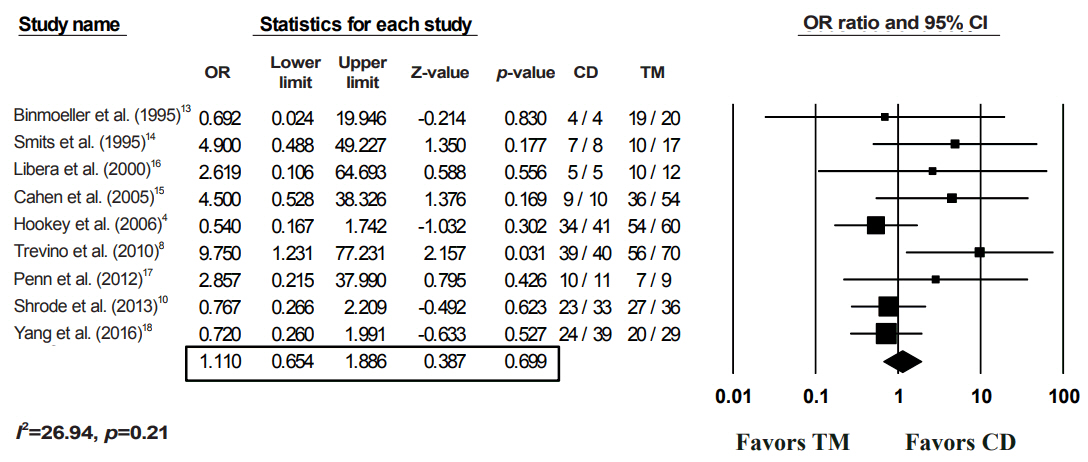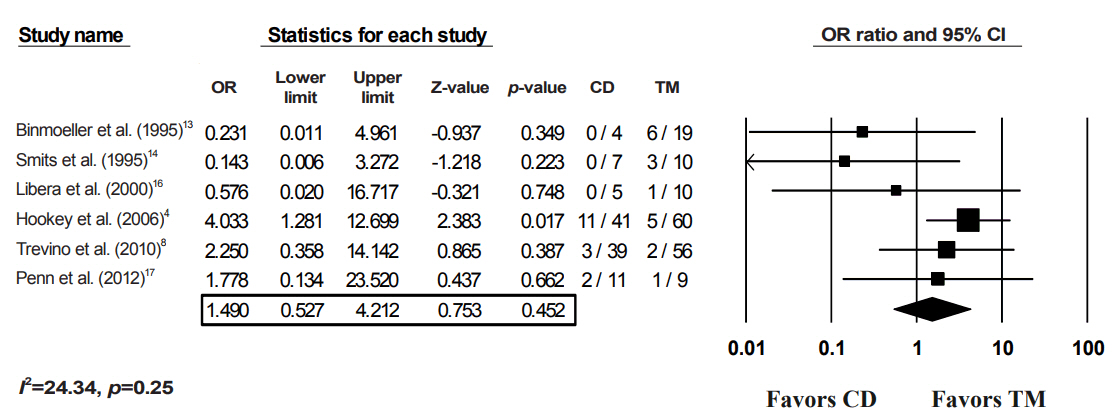Clin Endosc.
2017 Jul;50(4):388-394. 10.5946/ce.2016.091.
There Is No Advantage to Transpapillary Pancreatic Duct Stenting for the Transmural Endoscopic Drainage of Pancreatic Fluid Collections: A Meta-Analysis
- Affiliations
-
- 1Division of Gastroenterology, Department of Medicine, Icahn School of Medicine at Mount Sinai, New York, NY, USA. christopher.dimaio@mountsinai.org
- KMID: 2389245
- DOI: http://doi.org/10.5946/ce.2016.091
Abstract
- BACKGROUND/AIMS
Options for the endoscopic management of symptomatic pancreatic fluid collections (PFCs) include transmural drainage (TM) alone, transpapillary drainage (TP) alone, or a combination of both drainage method (CD). There have been conflicting reports about the best method. This study performed a meta-analysis to determine whether CD presents an added clinical benefit over TM.
METHODS
The included studies compared TM with CD and reported clinical success for both methods. A random-effects model was used to determine the pooled odds ratios (ORs) and the 95% confidence intervals (CIs) for the following outcomes: technical success, clinical success, complications, and recurrence.
RESULTS
Nine studies involving a combined total of 604 drainage procedures"”373 TMs (62%) and 231 CDs (38%)"”were included. CD showed no additional benefit over TM in terms of technical success (OR, 1.12; 95% CI, 0.37-3.37; p=0.85), clinical success (OR, 1.11; 95% CI, 0.65-1.89; p=0.70), recurrence (OR, 1.49; 95% CI, 0.53-4.21; p=0.45), or complications (OR, 1.15; 95% CI, 0.61-2.18; p=0.67).
CONCLUSIONS
Pancreatic duct (PD) stenting provides no additional clinical benefit for the TM of PFCs (particularly pseudocysts). Patients undergoing the TM of symptomatic pseudocysts may not require endoscopic retrograde pancreatography (ERP).
Keyword
MeSH Terms
Figure
Cited by 3 articles
-
Clinical Practice Guidelines for the Endoscopic Management of Peripancreatic Fluid Collections
Chi Hyuk Oh, Jun Kyu Lee, Tae Jun Song, Jin-Seok Park, Jae Min Lee, Jun Hyuk Son, Dong Kee Jang, Miyoung Choi, Jeong-Sik Byeon, In Seok Lee, Soo Teik Lee, Ho Soon Choi, Ho Gak Kim, Hoon Jai Chun, Chan Guk Park, Joo Young Cho
Clin Endosc. 2021;54(4):505-521. doi: 10.5946/ce.2021.185.False Reassurance Based on Non-Significant Results
Douglas G. Altman
Clin Endosc. 2017;50(6):617-617. doi: 10.5946/ce.2017.091.Is Endoscopic Ultrasound-Guided Drainage Alone Sufficient for the Treatment of Peripancreatic Fluid Collection?
Se Woo Park
Clin Endosc. 2017;50(4):316-317. doi: 10.5946/ce.2017.101.
Reference
-
1. Banks PA, Bollen TL, Dervenis C, et al. Classification of acute pancreatitis--2012: revision of the Atlanta classification and definitions by international consensus. Gut. 2013; 62:102–111.
Article2. Cheruvu CV, Clarke MG, Prentice M, Eyre-Brook IA. Conservative treatment as an option in the management of pancreatic pseudocyst. Ann R Coll Surg Engl. 2003; 85:313–316.
Article3. Soliani P, Franzini C, Ziegler S, et al. Pancreatic pseudocysts following acute pancreatitis: risk factors influencing therapeutic outcomes. JOP. 2004; 5:338–347.4. Hookey LC, Debroux S, Delhaye M, Arvanitakis M, Le Moine O, Devière J. Endoscopic drainage of pancreatic-fluid collections in 116 patients: a comparison of etiologies, drainage techniques, and outcomes. Gastrointest Endosc. 2006; 63:635–643.
Article5. Larsen M, Kozarek R. Management of pancreatic ductal leaks and fistulae. J Gastroenterol Hepatol. 2014; 29:1360–1370.
Article6. Varadarajulu S, Bang JY, Sutton BS, Trevino JM, Christein JD, Wilcox CM. Equal efficacy of endoscopic and surgical cystogastrostomy for pancreatic pseudocyst drainage in a randomized trial. Gastroenterology 2013;145:583-590.e1.7. Varadarajulu S, Lopes TL, Wilcox CM, Drelichman ER, Kilgore ML, Christein JD. EUS versus surgical cyst-gastrostomy for management of pancreatic pseudocysts. Gastrointest Endosc. 2008; 68:649–655.
Article8. Trevino JM, Tamhane A, Varadarajulu S. Successful stenting in ductal disruption favorably impacts treatment outcomes in patients undergoing transmural drainage of peripancreatic fluid collections. J Gastroenterol Hepatol. 2010; 25:526–531.
Article9. Stroup DF, Berlin JA, Morton SC, et al. Meta-analysis of observational studies in epidemiology: a proposal for reporting. Meta-analysis of observational studies in epidemiology (MOOSE) group. JAMA. 2000; 283:2008–2012.10. Shrode CW, Macdonough P, Gaidhane M, et al. Multimodality endoscopic treatment of pancreatic duct disruption with stenting and pseudocyst drainage: how efficacious is it? Dig Liver Dis. 2013; 45:129–133.
Article11. Wells GA, Shea B, O’Connell D, et al. The Newcastle-Ottawa scale (NOS) for assessing the quality of non-randomized studies in meta-analyses [Internet]. Ottawa: Ottawa Hospital Research Institute;c2014. [cited 2015 Jun 11]. Available from: http://www.ohri.ca/programs/clinical_epidemiology/oxford.asp.12. Sterne JA, Sutton AJ, Ioannidis JP, et al. Recommendations for examining and interpreting funnel plot asymmetry in meta-analyses of randomised controlled trials. BMJ. 2011; 343:d4002.
Article13. Binmoeller KF, Seifert H, Walter A, Soehendra N. Transpapillary and transmural drainage of pancreatic pseudocysts. Gastrointest Endosc. 1995; 42:219–224.
Article14. Smits ME, Rauws EA, Tytgat GN, Huibregtse K. The efficacy of endoscopic treatment of pancreatic pseudocysts. Gastrointest Endosc. 1995; 42:202–207.
Article15. Cahen D, Rauws E, Fockens P, Weverling G, Huibregtse K, Bruno M. Endoscopic drainage of pancreatic pseudocysts: long-term outcome and procedural factors associated with safe and successful treatment. Endoscopy. 2005; 37:977–983.
Article16. Libera ED, Siqueira ES, Morais M, et al. Pancreatic pseudocysts transpapillary and transmural drainage. HPB Surg. 2000; 11:333–338.17. Penn DE, Draganov PV, Wagh MS, Forsmark CE, Gupte AR, Chauhan SS. Prospective evaluation of the use of fully covered self-expanding metal stents for EUS-guided transmural drainage of pancreatic pseudocysts. Gastrointest Endosc. 2012; 76:679–684.
Article18. Yang D, Amin S, Gonzalez S, et al. Transpapillary drainage has no added benefit on treatment outcomes in patients undergoing EUS-guided transmural drainage of pancreatic pseudocysts: a large multicenter study. Gastrointest Endosc. 2016; 83:720–729.19. Varadarajulu S, Bang JY, Phadnis MA, Christein JD, Wilcox CM. Endoscopic transmural drainage of peripancreatic fluid collections: outcomes and predictors of treatment success in 211 consecutive patients. J Gastrointest Surg. 2011; 15:2080–2088.
Article20. Park DH, Lee SS, Moon SH, et al. Endoscopic ultrasound-guided versus conventional transmural drainage for pancreatic pseudocysts: a prospective randomized trial. Endoscopy. 2009; 41:842–848.
Article21. Kahaleh M, Shami VM, Conaway MR, et al. Endoscopic ultrasound drainage of pancreatic pseudocyst: a prospective comparison with conventional endoscopic drainage. Endoscopy. 2006; 38:355–359.
Article22. Varadarajulu S, Christein JD, Tamhane A, Drelichman ER, Wilcox CM. Prospective randomized trial comparing EUS and EGD for transmural drainage of pancreatic pseudocysts (with videos). Gastrointest Endosc. 2008; 68:1102–1111.
Article23. Panamonta N, Ngamruengphong S, Kijsirichareanchai K, Nugent K, Rakvit A. Endoscopic ultrasound-guided versus conventional transmural techniques have comparable treatment outcomes in draining pancreatic pseudocysts. Eur J Gastroenterol Hepatol. 2012; 24:1355–1362.
Article
- Full Text Links
- Actions
-
Cited
- CITED
-
- Close
- Share
- Similar articles
-
- Endoscopic Ultrasound-Guided Drainage of Pancreatic Fluid Collections (with Video)
- A Case of Pancreatic Pseudocyst Resolved by Transpapillary Drainage via the Main Pancreatic Duct
- Technical tips for endoscopic ultrasound-guided pancreatic duct access and drainage
- Endoscopic Ultrasound-Guided Pancreatic Transmural Stenting and Transmural Intervention
- Metal versus Plastic Stent for Transmural Drainage of Pancreatic Fluid Collections






